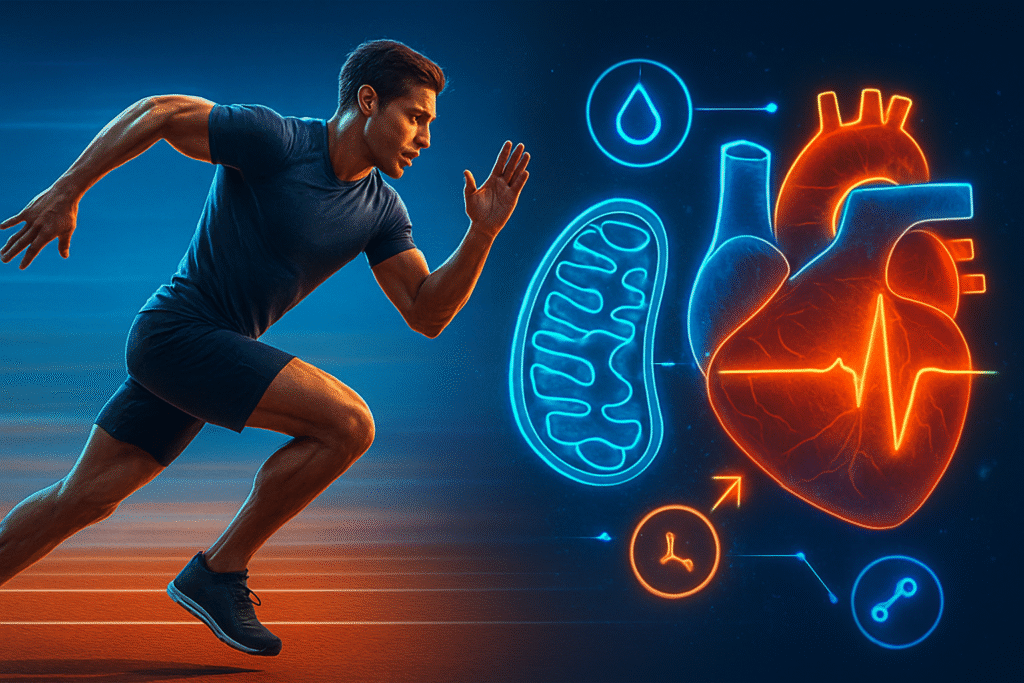Introduction
High‑intensity interval training (HIIT) has surged from elite sports labs to living‑room workout apps, promising maximum results in minimum time. The Science Behind HIIT: Understanding the Physiology and Benefits of High‑Intensity Interval Training is more than a catchy headline—it’s a roadmap to how our bodies transform under short bursts of maximal effort followed by brief recovery. By dissecting the cellular, hormonal, and cardiovascular responses that occur during a HIIT session, we can appreciate why this training modality improves aerobic capacity, burns fat, and supports long‑term health. Below, we’ll explore the underlying mechanisms, real‑world applications, and evidence‑based strategies to make HIIT work for you.
Whether you’re a busy professional, a seasoned athlete, or someone new to exercise, understanding the science equips you to tailor workouts, avoid common pitfalls, and track progress with confidence. In the sections that follow, we’ll translate peer‑reviewed research into practical tips, compare HIIT with traditional training, and provide a step‑by‑step guide so you can harness its benefits safely and effectively.
How HIIT Triggers Metabolic Remodeling: The Core Physiology of Interval Training

During a HIIT bout, the body experiences rapid oscillations between supramaximal effort and active recovery. This pattern forces the cardiovascular system to increase stroke volume and heart rate dramatically, pushing oxygen uptake (VO₂) to near‑maximal levels within seconds. The subsequent recovery phase lowers oxygen demand, yet the metabolic “after‑burn”—known as excess post‑exercise oxygen consumption (EPOC)—remains elevated for up to 48 hours. Research from the American College of Sports Medicine shows EPOC can increase calorie expenditure by 6‑15 % compared with steady‑state cardio, largely due to heightened mitochondrial respiration and substrate turnover.
On a cellular level, HIIT stimulates AMP‑activated protein kinase (AMPK) and peroxisome proliferator‑activated receptor‑γ coactivator‑1α (PGC‑1α), both master regulators of mitochondrial biogenesis. Within weeks, trained individuals exhibit up to a 30 % rise in mitochondrial density in skeletal muscle, translating to improved oxidative capacity and a reduced reliance on glycogen stores. This metabolic remodeling not only boosts endurance performance but also enhances insulin sensitivity, a key factor in preventing type 2 diabetes (Burgomaster et al., 2008).
Cardiovascular Adaptations: Why HIIT Improves VO₂ Max Faster Than Traditional Cardio
VO₂ max—the gold standard for aerobic fitness—reflects the maximal amount of oxygen your body can transport and utilize during intense exercise. HIIT challenges this system by repeatedly pushing the heart to operate at 85‑95 % of its maximal capacity, prompting structural and functional cardiac adaptations. A meta‑analysis of 31 randomized controlled trials (RCTs) found that HIIT increased VO₂ max by an average of 9 % after just six weeks, outperforming moderate‑intensity continuous training (MICT) which yielded a 5 % increase.
These gains stem from several mechanisms: increased capillary density (angiogenesis), enhanced stroke volume, and improved blood‑volume distribution. Moreover, the sympathetic–parasympathetic balance shifts, lowering resting heart rate and blood pressure—a benefit confirmed by a 2021 systematic review that reported an average systolic BP reduction of 5 mm Hg in hypertensive participants after 8 weeks of HIIT. For beginners, this means a quicker route to cardiovascular health without spending hours on the treadmill.
Hormonal Responses and Fat Loss: Leveraging the Endocrine System for Real‑World Results
HIIT triggers a cascade of hormonal responses that accelerate lipolysis and preserve lean muscle. During high‑intensity intervals, catecholamines (epinephrine and norepinephrine) surge, stimulating β‑adrenergic receptors on adipocytes and mobilizing fatty acids into the bloodstream. Simultaneously, growth hormone (GH) spikes, aiding in protein synthesis and muscle repair. Studies have shown that post‑exercise GH levels can be three times higher after a 20‑minute HIIT session than after a comparable MICT session.
Importantly, insulin sensitivity improves dramatically after HIIT, reducing circulating insulin and limiting fat storage. A landmark trial involving sedentary overweight adults demonstrated a 23 % reduction in fasting insulin after eight weeks of thrice‑weekly HIIT, whereas the control group showed no change. This metabolic shift contributes to greater fat oxidation both during and after workouts, supporting sustainable weight loss without drastic calorie restriction.
Practical tip: Pair HIIT with a protein‑rich snack (e.g., Greek yogurt with berries) within 30 minutes post‑session to capitalize on the anabolic window opened by GH and to replenish glycogen without triggering insulin spikes.
Comparing HIIT With Traditional Training Benefits, Limitations, and When to Choose Each

When it comes to time efficiency, HIIT clearly ou
tperforms steady‑state cardio. A typical 20‑minute HIIT protocol can deliver similar or superior cardiovascular and metabolic benefits compared to 45‑60 minutes of moderate cycling or jogging. However, the high intensity does raise the risk of overuse injuries, especially in beginners lacking proper movement mechanics. Hence, it’s essential to incorporate a solid warm‑up and progressive overload, gradually increasing interval length or intensity over weeks.
From a psychological perspective, many athletes report greater enjoyment and perceived challenge with HIIT, which can improve adherence. Yet, some individuals experience heightened perceived exertion (RPE ≥ 8) that discourages repeat sessions. In contrast, low‑impact steady‑state exercise may be more suitable for those recovering from injuries, older adults, or people with certain chronic conditions. The key is to match the program to personal goals, fitness level, and lifestyle constraints.
Side‑by‑side comparison chart:
| Aspect | HIIT | Traditional Cardio (MICT) |
|---|---|---|
| Time Commitment | 15‑30 min/session | 45‑60 min/session |
| VO₂ max Gains | ≈9 % (6‑weeks) | ≈5 % (6‑weeks) |
| Calorie Burn (post‑exercise) | ↑ EPOC 6‑15 % | ↓ EPOC 2‑5 % |
| Injury Risk | Higher (if unsupervised) | Lower |
| Suitability for Beginners | Requires progression | Immediately accessible |
Designing an Effective HIIT Program: Tools, Protocols, and Step‑by‑Step Guidance
To build a reliable HIIT routine, start with the classic 1:2 work‑to‑rest ratio (e.g., 30 seconds sprint, 60 seconds walk) and aim for a total work time of 10‑15 minutes. As fitness improves, experiment with 2:1 or even 1:1 ratios for greater stimulus. Below is a beginner‑to‑intermediate progression:
-
- Week 1‑2: 5 × 30 s high intensity (RPE 9) + 60 s active recovery; total 8 min.
-
- Week 3‑4: 6 × 40 s high intensity + 40 s recovery; total 8 min.
-
- Week 5‑6: 8 × 30 s high intensity + 30 s recovery; total 8 min.
-
- Week 7‑8: 10 × 20 s all‑out sprints + 20 s recovery; total 8 min.
Use a heart‑rate monitor or a wearable (e.g., Garmin, Whoop) to keep intensity within 85‑95 % of your HRmax. Track perceived exertion (Borg RPE scale) alongside heart‑rate data to ensure you’re truly pushing hard. For variety, integrate body‑weight circuits (burpees, jump squats, mountain climbers) or equipment‑based intervals (rowing, battle ropes). Apps like HIITometer or Seconds Pro provide customizable timers and progress logs, facilitating consistency.
Every session should end with a 5‑minute cool‑down (light jog, mobility drills) and stretching to mitigate delayed‑onset muscle soreness (DOMS). Incorporating foam‑rolling or dynamic stretching on recovery days helps maintain tissue pliability and reduces injury risk, especially when HIIT frequency reaches 3–4 times per week.
Addressing Common Concerns: FAQs, Myths, and Safety Tips
FAQ 1 – Can I do HIIT every day? While the metabolic boost is attractive, most experts recommend 2‑4 sessions per week, allowing 48‑72 hours of recovery for muscle repair and hormonal balance. Overtraining can blunt performance gains and increase cortisol levels.
FAQ 2 – Is HIIT safe for older adults? Yes, with modifications. Lower‑impact intervals (e.g., cycling, elliptical) reduce joint stress. A 2022 meta‑analysis on adults ≥ 60 years found significant improvements in VO₂ max and gait speed after 12 weeks of low‑impact HIIT, with no adverse events when supervised.
Myth – HIIT burns more calories during the workout than steady cardio. Actual in‑session calorie burn is often similar or slightly lower because HIIT intervals are short. The real advantage lies in the post‑exercise oxygen consumption (EPOC) and hormonal milieu that continue to oxidize fat for afterward.
Safety checklist before each HIIT session:
-
- Complete a 5‑minute dynamic warm‑up (leg swings, arm circles).
-
- Confirm proper form—especially for jumps or sprints.
-
- Monitor heart‑rate and stop if it exceeds 95 % of HRmax or you feel dizziness.
-
- Stay hydrated; electrolytes are essential for high‑intensity bursts.
-
- Finish with a cool‑down and stretch to aid recovery.
Conclusion: Harness the Science, Transform Your Fitness

Understanding The Science Behind HIIT: Understanding the Physiology and Benefits of High‑Intensity Interval Training equips you to use this powerful modality intelligently. By leveraging metabolic remodeling, cardiovascular adaptations, and hormonal responses, HIIT delivers rapid improvements in fitness, body composition, and overall health—often in a fraction of the time required by traditional cardio. Remember to progress gradually, respect recovery, and employ evidence‑based protocols for safety and maximal results.
If you found this guide valuable, please share it on social media, leave a comment with your HIIT experiences, or explore our related articles on “Optimizing Nutrition for High‑Intensity Workouts” and “Preventing Injury During Interval Training.” Let’s build a community that thrives on science‑backed fitness, one interval at a time!

